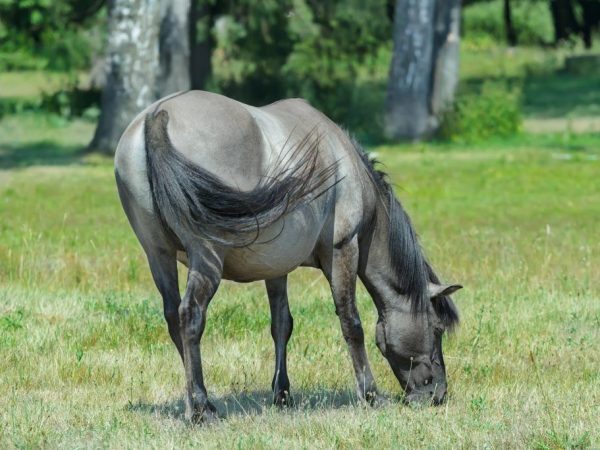Feature of the breed Mouse horse
Among the large number of horse colors known to man, the Mouse Horse occupies, perhaps, the most honorable place in its beauty. As if descended from the pages of a fairy tale, thanks to its atypical color, the animal is one of the most beautiful creatures on earth. What is so unusual about the claimed suit? How is such an individual different from the rest of the horses?

Mouse horse
Origin and description
Researchers suggest that the mouse-colored horse has a wild ancestor called tarpans. They were hardy animals that lived in the steppe areas of Europe. They had a strip in the form of a belt along the spine, a short tail and on the legs a color resembling a zebra (zebra-like). The height of the horses could reach 137 cm at the withers. Tarpan was hunted for delicious meat and skins, but it was impossible to tame them: these horses died in captivity.
As a result, this wild species was exterminated about 200 years ago (only hybrids have survived to this day).
The mouse breed was bred artificially by breeders. The subspecies Polish equestrian took part in the crossing.
Horses of "blue blood"
The mouse suit belongs to those animals that are descendants of the above-mentioned breeds. Some called this suit "Blue Horse" because of the hair dyed in ashy color, which shimmered in the sun and shimmered blue. It is not for nothing that in the fairy tale about Cinderella, horses of this particular color were harnessed to the carriage: the girl was supposed to appear in the best light at the ball. Muscular horses were also popular in higher circles.
Features that are characteristic of the "Blue Horses":
- ashy shade;
- tail and mane, as well as limbs of a darker color than the body of the individual;
- a strip along the ridge of a dark color.
The combination of the features listed above allows us to conclude that a horse of this color is one of the most valuable among representatives of different colors of horses, which allows you to admire its beauty and grace (a photo of a unique color of horses can be found on the Internet).
Basic shades
Hearing such an interesting name, one wonders: what is a mouse horse?
Each subspecies is unique. A muscular horse is characterized by a variety of shades, therefore, there are dozens of margins. Let's consider the most basic ones:
- Dark. The breed has gray hair with darker limbs. A stripe along the spine, mane and tail of the same shade, up to black.
- Light coloured. The body of a mousey mare has an almost white tint (with a gray admixture). Colors from white to blackish are inherent in the colors of the legs, mane and tail. The belt of such individuals is dark gray.
- Mukhorty. It is characterized by blotches of reddish or slightly yellow color around the eyes and mouth, as well as in the thighs and groin areas. This type of color is rare.
It should be noted that the color of the mouse-like horse does not change with age, unlike other varieties, which, in winter, have a silvery tone with a blue tint, and in summer they have a more yellowish tint.
Difference from other suits
An individual of a mouse-colored suit can be easily distinguished among the herd according to the following features:
- The black stripe running along the ridge is a special difference. With this feature, the mouse-haired horse stands out very much against the background of other individuals.
- In gray horses, the tone is created by mixing black and white body hair, and the mouse horse has single-colored hairs of ash or golden colors (without any combination).
- The wild horse demonstrates color stability, the stallion does not change its color with the advent of puberty.
Previously, their ancestors were wild tarpans, and thanks to genes, no matter how old the horse was, no matter what conditions the individual was in, the color of the animal remained the same throughout its life. With the onset of cold weather, a modern horse can change its color, and with maturity - the texture of the hairline, but the ashy shade will remain forever. It is also common for such horses to turn gray.
Experienced horse breeders argue that the colors of the suit do not affect the horse's ability to work, its activity (the character of the animal depends on the state of its nervous system).
In captivity, horses need the care of people, responsible care and attention, because they are one of the most loyal animals, loyal friends of man.
At the stud farms you can see horses of different kinds. This is evidence that the wild tarpan gene is practically absent in the created individuals, therefore, in the end, we note that horses of a mouse-colored suit are rare and are almost exotic in the modern world.


